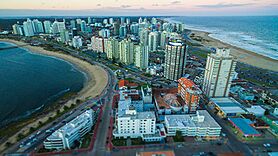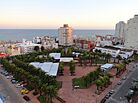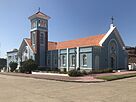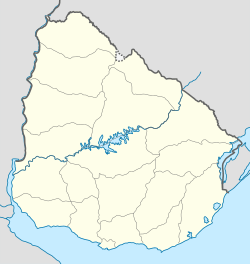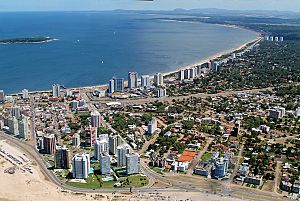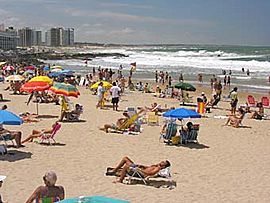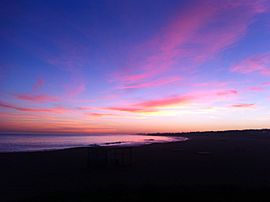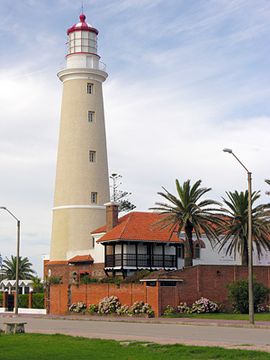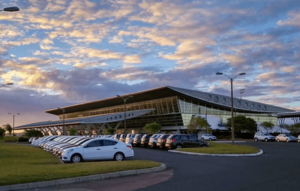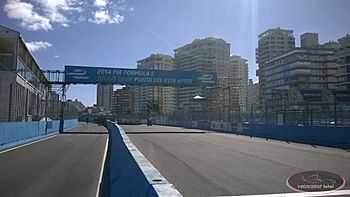Punta del Este facts for kids
Quick facts for kids
Punta del Este
|
|
|---|---|
|
City
|
|
|
View from above
The Hand sculpture
Enjoy Hotel and Casino
Central Square
Church of Our Lady of Candelaria
Homes on the peninsula
Mansa Beach
|
|
| Country | |
| Department | |
| Founded | 1860 |
| Area | |
| • Total | 20.35 km2 (7.86 sq mi) |
| Population
(2011 Census)
|
|
| • Total | 12,423 |
| Demonym(s) | puntaesteño (m) puntaesteña (f) |
| Time zone | UTC−3 |
| Postal code |
20100
|
| Dial code | +598 42 (+6 digits) |
| Climate | Cfb |
Punta del Este is a beautiful city by the sea in Uruguay. It sits on a peninsula (a piece of land almost surrounded by water) on the Atlantic Coast. This city started as a small town. Over time, it became a very popular vacation spot for famous people and tourists from all over the world.
Punta del Este is sometimes called "The Monaco of the South" or "The Pearl of the Atlantic." It has also been compared to places like the Hamptons or Miami Beach in South America. Many well-known people have visited or bought vacation homes here.
The city has hosted important international events. These include yacht races like the Whitbread Around the World race. It also hosted the Uruguay Round of trade talks in 1986. These talks led to the creation of the World Trade Organization (WTO). Punta del Este has also held car races, like the Formula E Championship in 2014.
The area has many cool places to visit. These include natural reserves like Isla de Lobos (Island of Wolves) and Gorriti Island. Famous landmarks are the giant sculpture La Mano (The Hand). There is also the unique Santorini-style building complex called Casapueblo. The Rafael Viñoly-designed Puente Garzón bridge is also a sight to see. You can also visit the Museum of the Sea.
Even though about 12,400 people live here all year, the city gets much bigger in the summer. Many more people come to enjoy the beaches and activities.
Contents
Exploring Punta del Este
Where is Punta del Este?
Punta del Este is located in southeastern Uruguay. It is about 140 kilometers (87 miles) east of Montevideo, the capital city. The city is found where Route 10 and Route 39 meet. It is southeast of Maldonado, which is the capital of its department.
What is the Weather Like?
Punta del Este has an oceanic climate. This means it has pleasant summers and cool winters. The weather is similar to southeastern Australia. The rain is spread out evenly throughout the year. On average, it gets about 1,010 millimeters (40 inches) of rain each year.
The warmest month is February, with an average temperature of about 21.7 °C (71.1 °F). The coldest month is July, with an average of about 11.5 °C (52.7 °F). The average temperature for the whole year is about 16.4 °C (61.5 °F).
| Climate data for Punta del Este (Península), elevation: 16 m, 1961–1990 normals | |||||||||||||
|---|---|---|---|---|---|---|---|---|---|---|---|---|---|
| Month | Jan | Feb | Mar | Apr | May | Jun | Jul | Aug | Sep | Oct | Nov | Dec | Year |
| Record high °C (°F) | 37.0 (98.6) |
34.4 (93.9) |
34.4 (93.9) |
30.6 (87.1) |
29.8 (85.6) |
26.6 (79.9) |
28.3 (82.9) |
27.4 (81.3) |
31.0 (87.8) |
31.8 (89.2) |
32.2 (90.0) |
37.6 (99.7) |
37.6 (99.7) |
| Mean daily maximum °C (°F) | 25.2 (77.4) |
25.1 (77.2) |
24.0 (75.2) |
21.2 (70.2) |
18.2 (64.8) |
14.8 (58.6) |
14.4 (57.9) |
14.7 (58.5) |
16.0 (60.8) |
18.4 (65.1) |
21.0 (69.8) |
23.8 (74.8) |
19.7 (67.5) |
| Daily mean °C (°F) | 21.6 (70.9) |
21.7 (71.1) |
20.6 (69.1) |
17.9 (64.2) |
15.0 (59.0) |
12.2 (54.0) |
11.5 (52.7) |
11.6 (52.9) |
12.8 (55.0) |
15.0 (59.0) |
17.4 (63.3) |
20.0 (68.0) |
16.4 (61.5) |
| Mean daily minimum °C (°F) | 18.1 (64.6) |
18.4 (65.1) |
17.6 (63.7) |
14.9 (58.8) |
12.1 (53.8) |
9.5 (49.1) |
8.7 (47.7) |
8.8 (47.8) |
9.9 (49.8) |
11.4 (52.5) |
14.1 (57.4) |
16.4 (61.5) |
13.3 (55.9) |
| Record low °C (°F) | 10.2 (50.4) |
11.6 (52.9) |
10.4 (50.7) |
6.8 (44.2) |
3.4 (38.1) |
−0.2 (31.6) |
1.4 (34.5) |
1.4 (34.5) |
1.6 (34.9) |
4.0 (39.2) |
7.4 (45.3) |
7.0 (44.6) |
−0.2 (31.6) |
| Average precipitation mm (inches) | 75.4 (2.97) |
84.8 (3.34) |
79.3 (3.12) |
84.0 (3.31) |
91.4 (3.60) |
80.3 (3.16) |
90.3 (3.56) |
93.9 (3.70) |
93.1 (3.67) |
85.0 (3.35) |
86.8 (3.42) |
66.6 (2.62) |
1,010.9 (39.82) |
| Average precipitation days | 8 | 9 | 9 | 9 | 9 | 10 | 10 | 9 | 9 | 9 | 8 | 8 | 107 |
| Mean monthly sunshine hours | 263.8 | 212.5 | 243.0 | 181.3 | 147.0 | 103.8 | 118.8 | 157.5 | 169.3 | 234.5 | 217.5 | 289.3 | 2,338.3 |
| Source 1: WMO | |||||||||||||
| Source 2: NOAA (extremes, sun and mean temperature) | |||||||||||||
History of Punta del Este
Europeans first arrived in the Punta del Este area in the early 1500s. The Spanish were the first to explore here. Later, in the late 1700s, people started to settle around Maldonado.
In 1896, a man named Antonio Lussich bought a large area of land. It was mostly sand and dunes back then. He started a special garden called Arboretum Lussich. He planted trees and plants from all over the world. Many of these trees, like Pines and Eucalyptus, grew and spread on their own.
Punta del Este was officially named a "Pueblo" (village) on July 5, 1907. It became a "Ciudad" (city) on July 2, 1957.
In the 1970s, the city saw fewer tourists. But in the 1980s, Punta del Este grew a lot. Many new buildings, apartment towers, and hotels were built. This building boom helped the city's economy. Today, more and more people are choosing to live in Punta del Este all year round. They enjoy the peaceful nature and growing number of schools.
Population of Punta del Este
In 2011, the city of Punta del Este had a population of 9,277 people. There were also 23,954 homes and apartments. The wider area of Punta del Este has about 15,000 people. People from Argentina, Brazil, and Europe are moving here to live permanently. They like the calm environment and the good educational options.
| Year | Population |
|---|---|
| 1963 | 5,272 |
| 1975 | 7,197 |
| 1985 | 6,731 |
| 1996 | 8,294 |
| 2004 | 7,298 |
| 2011 | 9,277 |
Source: Instituto Nacional de Estadística de Uruguay
Views of Punta del Este
Coastline and Beaches
Punta del Este's beautiful coastline is split into two main areas: Brava (meaning "fierce") and Mansa (meaning "tame"). These names describe the waves. The point where these two sides meet marks the end of the Río de la Plata and the start of the Atlantic Ocean.
The famous Mano de Punta del Este sculpture marks this spot. The artist created it to warn swimmers about the strong waves on the Brava side. Beaches on the Mansa side have thick, golden sand and calm waters. On the Brava side, the sand is white and fine, and the waves are rougher. All beaches in Punta del Este are open to the public.
La Barra is a popular spot for water sports and fishing during the day. At night, it becomes a lively place for young people. From late December to mid-January, it's a hub for nightlife and parties. Other popular beaches include El Tesoro, Montoya, Bikini, and Manantiales. These beaches are favorites for young people and many celebrities.
Southern right whales are returning to this area. This has helped create a whale sanctuary off Latin America. Unlike most of Uruguay's coast, orcas have also been seen here, especially around Isla de Lobos.
Famous Landmarks
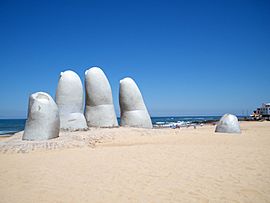
Punta del Este has a mix of old colonial buildings and modern ones. It has a beautiful shoreline, charming resort houses, and a port for boats. You can find department stores, restaurants, and pubs here. The city also has many large houses and lovely gardens.
The historic Hotel L'Auberge is a famous building on Brava Beach. It is 70 years old and known for its hospitality. They still serve their traditional Belgian waffles with homemade sauces.
Gorlero Avenue is the main street in Punta del Este. It has shopping centers, restaurants, movie theaters, and casinos. Artigas Square, located on Gorlero Avenue, hosts a popular handicraft market.
Punta del Este is also known for hosting the meeting where the WTO was created. The Formula E electric car races have been held here several times. The city's "absolutely landmark cityscape" makes it a great race location. In 2017, the China-Latin America Forum also took place at the Punta del Este Convention Center.
Enjoy Punta del Este Hotel and Casino
Enjoy Punta del Este is a large hotel and casino. It was designed by Guillermo Gómez Platero. The hotel has 294 rooms, including many fancy suites. It was first opened in 1997.
Fundación Pablo Atchugarry (Pablo Atchugarry Foundation)
This foundation is a leading art center in Uruguay. It was started in 2007 by the famous sculptor Pablo Atchugarry. Its goal is to connect art with nature. In the summer, the foundation hosts many events. These include art shows, concerts, and ballet performances. They also have a large sculpture park that covers 30 hectares (about 74 acres).
Punta del Este Lighthouse
The lighthouse in Punta del Este is 45 meters (148 feet) tall. Its special crystal panels for lighting were brought from France. It runs on electricity, with gas as a backup. You can climb its 150 spiral steps to the top.
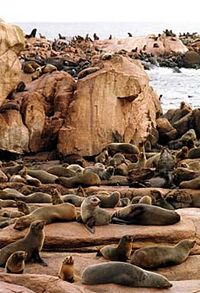
Gorriti Island
This island is 21 hectares (about 52 acres) in size. Many people visit it daily to enjoy its two beaches: Garden Port and Honda Beach. It has a natural harbor where ships can anchor. It's also a popular place for water sports.
Getting Around
Punta del Este has its own airport, Capitán de Corbeta Carlos A. Curbelo International Airport. It is the second most important airport in Uruguay. It opened in 1996 and offers flights within the region.
Most international flights land at Carrasco International Airport in Montevideo. This airport is about 115 kilometers (71 miles) from Punta del Este. Bus companies like Copsa and Cot connect Montevideo's airport to Punta del Este. Taxis and private car services are also available.
There is also a smaller airport closer to Punta del Este called El Jagüel Airport. It is only used by small private planes.
Places to Worship
Punta del Este has several places of worship for different faiths:
- Parish Church of Our Lady of Candelaria (Roman Catholic)
- Fátima Chapel (Roman Catholic)
- St. Raphael Chapel (Roman Catholic)
- Rafael Temple (Jewish)
- Beit Yaacov (Jewish)
- Beit Jabad (Jewish-Chabad)
Fun Activities
Punta del Este offers many fun things to do. You can enjoy music and cinema festivals. It's also a great place for whale watching. The city has many excellent restaurants.
The city hosted the Punta del Este ePrix electric car races in 2014, 2015, and 2018. The race track is 2.8 kilometers (1.7 miles) long. It runs along Punta del Este's harbor and is sometimes called the Monte Carlo of South America.
The Uruguay Sevens rugby competition started in Punta del Este in 1989.
Notable People from Punta del Este
- Margaret Cooper (1918–2016), a British code-breaker, was born here.
- Juan Cáceres (1984–), a Uruguayan racing driver, was born here.
- Nahitan Nandez (1995–), a Uruguayan football (soccer) player, was born here.
|
See also
 In Spanish: Punta del Este para niños
In Spanish: Punta del Este para niños


